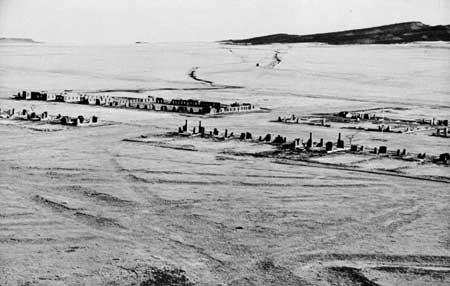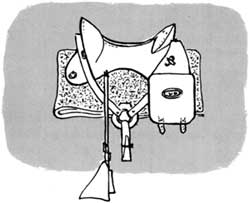|
FORT UNION National Monument |
 |

Post of Fort Union (right) and Fort Union Depot
(left). Santa Fe Trail ruts parallel fort on opposite side. Ruts in center
represent timber roads to the Turkey Mountains.
Photo by Laura Gilpin.
THE RUINS OF FORT UNION graphically commemorate the achievements of the men who won the West. Located on the route of the Santa Fe Trail where the mountains meet the plains, the fort is centered in a region full of historic events and brimming with the romance of the frontier. As a base of operations for both military and civilian ventures in New Mexico for 40 years, 1851 to 1891, Fort Union played a key role in shaping the destiny of the Southwest.
The historic features to be seen at Fort Union in fact expose a cross section of the entire sweep of 19th-century history in the Southwest. The site of the first fort, built in 1851, illustrates the formative years of New Mexico Territory. American newcomers at this time were imposing their institutions on the patterns of life evolved by native New Mexicans during 250 years of Spanish and Mexican rule, and the first halting attempts began at tearing down the Indian barrier that stretched north to Canada and barred the paths of westward expansion. The earthen star fort, built in 1861, illustrates the troublesome Civil War years, when loyalties of Americans and native Spaniards alike were violently tested and the Confederacy made a vigorous attempt to conquer New Mexico. The ruins of the third fort, begun in 1863, illustrate the stirring drama of subjugating the Indians of the Great Plains and Southwestern deserts. In 1890 the frontier passed our of existence. Appropriately, Fort Union was abandoned in February 1891.
The grasslands around Fort Union are deeply marked with the wagon ruts of the Santa Fe Trail. Indeed, throughout much of the High Plains region, the marks of the trail have remained undisturbed for more than a century. This wilderness highway provided a channel through which 19th-century Americans expressed the great motivating ideal of Manifest Destiny. First, the trail bore a commerce that within the short span of 25 years linked New Mexico so firmly to the United States that annexation was but a question of time. Next, in 1846, it bore an army of conquest that brought New Mexico under the American flag. Finally, it served until the coming of the railroad as the lifeline of New Mexico. The ruts of the Santa Fe Trail and the ruins of Fort Union recall a procession of people and events that enormously influenced the course of United States history.


|
|
Last Modified: Sat, Sep 28 2002 10:00:00 pm PDT |


